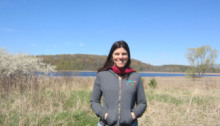Next Generation Science Standards: Offering Equitable Opportunities for ELLs to Engage in Science
Next Generation Science Standards: Offer Equitable Opportunities for ELLs to Engage in Science
 How-do-you-do, Everyone!
How-do-you-do, Everyone!
We are very excited to share a new article from Colorín Colorado written by Emily Miller, a 2nd- and 3rd-course bilingual resource teacher for the Madison, WI Metropolitan School District. Emily served on the Adjacent Generation Science Standards' (NGSS) Elementary Writing Squad also equally the Diversity & Disinterestedness Team, and she was previously featured on our blog.
The job of the Diversity & Equity Squad was to ensure that the NGSS are accessible to diverse populations of students. The team assessed accessibility through bias reviews of the standards, teaching the NGSS in their classrooms during the writing procedure, and writing almost their experiences in the form of case studies. The populations that the team focused on include the post-obit:
- Instance Report ane: Economically Disadvantaged
- Case Study ii: Race and Ethnicity
- Case Study iii: Students with Disabilities
- Instance Study 4: English Learners
- Instance Study 5: Girls
- Case Report 6: Alternative Education
- Instance Study 7: Gifted and Talented Students
(Run across additional information in Appendix D: Making the Side by side Generation Science Standards Accessible to All Students.)
New Opportunities for ELLs in Science Class
Emily was responsible for writing the ELL case study based on her classroom instruction. Drawing from that experience, in her new Colorín Colorado article, Emily highlights four of the eight NGSS science and applied science practices that she believes volition provide ELLs with more equitable science learning opportunities, which include:
- The use of crosscutting concepts
- The science and engineering do of modeling
- The practice of developing explanations and designing solutions
- The add-on of engineering practices and cadre ideas
Later explaining what each exercise looks like, Emily describes why the practise is particularly well-suited for engaging ELLs, too as related opportunities for language development. She too has compiled a nautical chart of science education strategies for ELLs that focus on building academic language and background knowledge such as literacy support strategies and discourse back up strategies.
TESOL Academy 2014
Emily volition be presenting at the TESOL Academy 2014 at The Ohio State University on June 20-21, 2014. Her session is titled Designing NGSS Science Lessons for All Students (C-2).
More Scientific discipline Resources for ELLs
For additional ideas and resources related to scientific discipline educational activity for ELLs, have a look at our new science resource section! Information technology includes classroom strategies and vignettes focused on research-based learning, updated research reports, recommended books for professionals, bilingual fiction and non-fiction books for students, and bilingual tips for parents. Be sure to share these resources with your scientific discipline colleagues and let us know what you call up!
Related Colorín Colorado Blog Posts
- Education Science to English Linguistic communication Learners: What practice the NGSS Tell The states?
- Science and Language: Making Connections with the Next Generation Scientific discipline Standards
![]()
Source: https://www.colorincolorado.org/blog/next-generation-science-standards-offering-equitable-opportunities-ells-engage-science
0 Response to "Next Generation Science Standards: Offering Equitable Opportunities for ELLs to Engage in Science"
Post a Comment